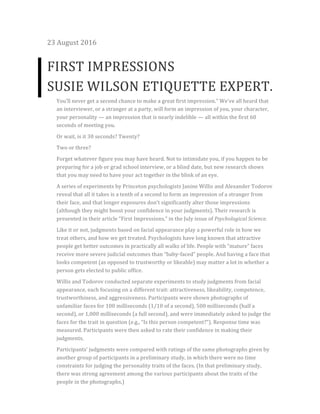23 August 2016 First Impressions paper
- Psychologists Janine Willis and Alexander Todorov conducted experiments showing that people form impressions of others from facial appearances within 1/10th of a second, and longer exposures do not significantly change these initial impressions. - Their research found judgments based on very brief (100 millisecond) exposures to faces strongly correlated with judgments made without time limits, and response times showed people made trait judgments just as quickly from brief exposures. - Of the five traits studied (attractiveness, likeability, competence, trustworthiness, aggressiveness), trustworthiness judgments from brief exposures had the highest correlation with unlimited viewing times, suggesting an evolved ability to quickly assess trustworthiness in others may have been important for survival.


Recommended
























































More Related Content
Featured (20)










































